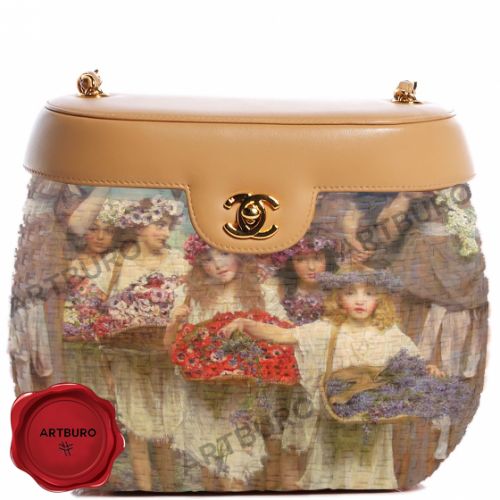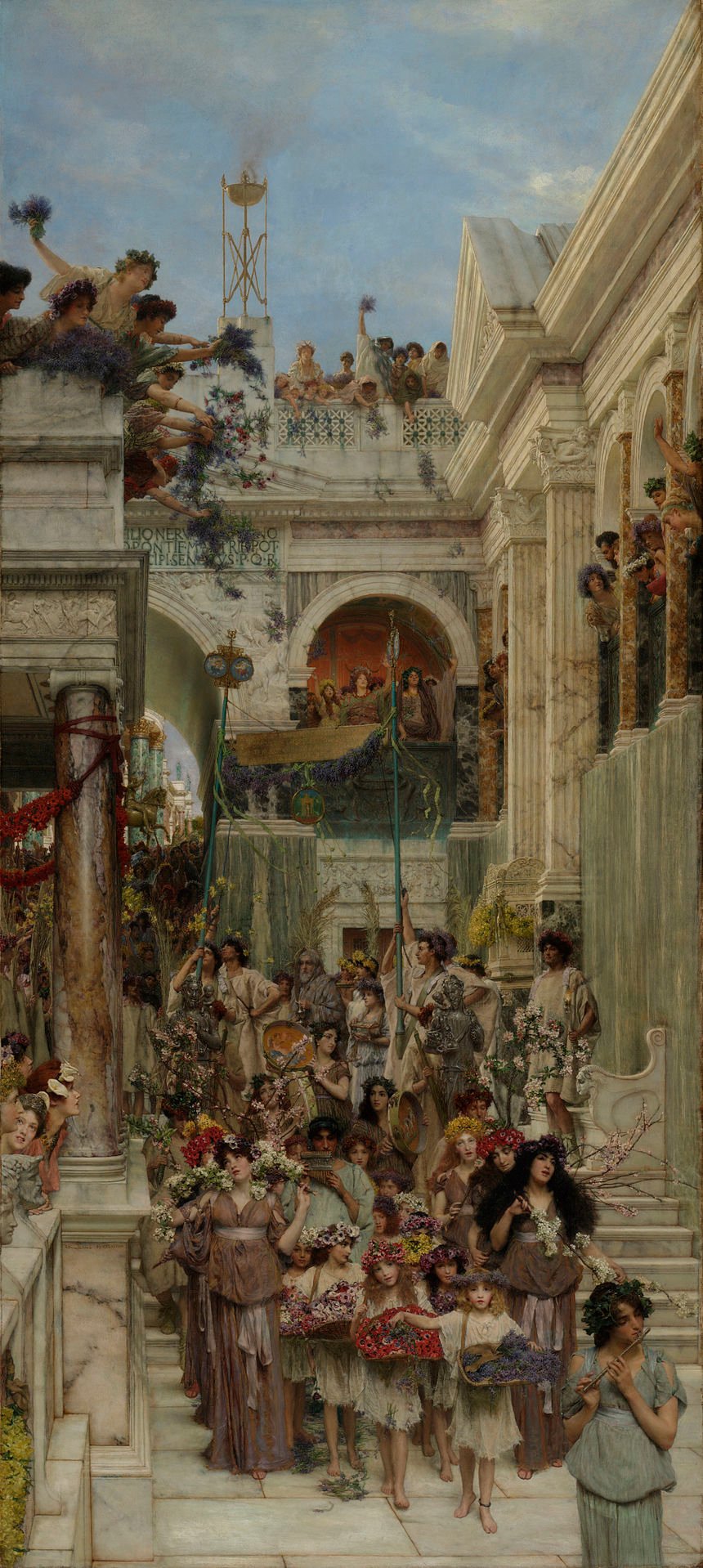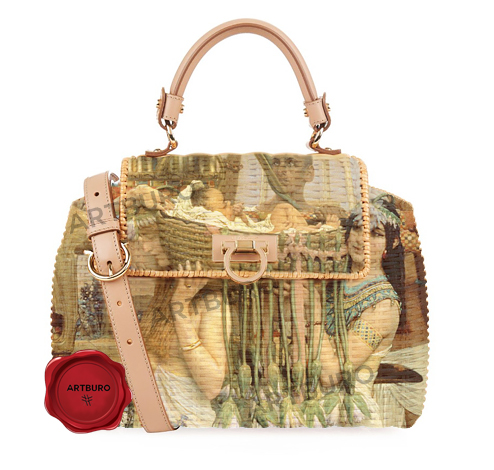Sir Lawrence Alma-Tadema (January 8, 1836, Dronrijp, the Netherlands.- June 25, 1912 Wiesbaden, Germany) was one of the most renowned painters of late nineteenth century Britain.
Born in Dronrijp, the Netherlands, and trained at the Academy of Antwerp, Belgium, he settled in England in 1870 and spent the rest of his life there.
A classical-subject painter, he became famous for his depictions of the luxury and decadence of the Roman Empire, with languorous figures set in fabulous marbled interiors or against a backdrop of dazzling blue Mediterranean sea and sky.
Universally admired for his superb draftsmanship and depictions of Classical antiquity, during his lifetime, he fell into disrepute after his death and only in the last thirty years has his work been reevaluated for its importance within nineteenth-century English art.

EARLY WORKS
Merovingian themes were the painter’s favorite subject up to the mid-1860’s. It is perhaps in this series that we find the artist moved by the deepest feeling and the strongest spirit of romance.
However Merovingian subjects did not have a wide international appeal, so he switched to themes of life in ancient Egypt that were more popular.
On these scenes of Frankish and Egyptian life Alma-Tadema spent great energy and much research. In 1862 Alma-Tadema left Leys’s studio and started his own career, establishing himself as a significant classical-subject European artist.

1863 was to alter the course of Alma-Tadema’s personal and professional life: on January 3 his invalid mother died, and on September 24 he was married, in Antwerp City Hall, to Marie-Pauline Gressin, the daughter of Eugene Gressin, a French journalist of royal descent living near Brussels.
Nothing is known of their meeting and little of Pauline herself, as Alma-Tadema never spoke about her after her death in 1869.
Her image appears in a number of oils, though he painted her portrait only three times, the most notable appearing in My studio (1867). The couple had three children.

Their eldest and only son lived only a few months dying of smallpox. Their two daughters, Laurence (1864-1940) and Anna (1867-1943), both had artistic leanings: the former in literature, the latter in art. Neither would marry.
Alma-Tadema and his wife spent their honeymoon in Florence, Rome, Naples and Pompeii.
Chanel Beige Wicker Straw Bag hand painted by ARTBURO Personalization, Sir Lawrence Alma-Tadema painting.


This, his first visit to Italy, developed his interest in depicting the life of ancient Greece and Rome, especially the latter since he found new inspiration in the ruins of Pompeii, which fascinated him and would inspire much of his work in the coming decades.
During the summer of 1864, Tadema met Ernest Gambart, the most influential art dealer and impresario of the nineteenth century.
Gambart was highly impressed with the work of Tadema, who was then painting: Egyptian chess players (1865). The dealer recognizing at once the unusual gifts of the young painter: he gave him an order for twenty-four pictures and arranged for three of Tadema’s paintings to be shown in London.
In 1865, Tadema relocated to Brussels where he was named a knight of the Order of Leopold I.
On May 28 1869, after years of ill health, Pauline died at Schaerbeek, in Belgium, at the age of thirty-two, of smallpox.
Her death left Tadema disconsolate and depressed. He ceased painting for nearly four months. His sister Artje, who lived with the family, helped with the two daughters then aged five and two.
Artje took over the role of housekeeper and remained with the family until 1873 when she married.
During the summer Tadema himself began to suffer from a medical problem which doctors in Brussels were frustratingly unable to diagnose.
Gambart eventually advised him to go to England for another medical opinion. Soon after his arrival in London in December 1869, Alma-Tadema was invited to the home of the painter Ford Madox Brown.
There he met the seventeen years old Laura Theresa Epps and fell in love with her at first sight.


PERSONALITY
For all the quiet charm and erudition of his paintings, Alma-Tadema himself preserved a youthful sense of mischief.
He was childlike in his practical jokes and in his sudden bursts of bad temper, which could as suddenly subside into a most engaging smile.
In his personal life, Alma-Tadema was an extrovert and had a remarkably warm personality. He had most of the characteristics of a child, coupled with the admirable traits of a consummate professional.
A perfectionist, he remained in all respects a diligent, if somewhat obsessive and pedantic worker. He was an excellent businessman, and one of the wealthiest artists of the nineteenth century. Alma-Tadema was as firm in money matters as he was with the quality of his work.
As a man, Lawrence Alma-Tadema was a robust, fun loving and rather portly gentleman.
There was not a hint of the delicate artist about him; he was a cheerful lover of wine, women and parties.

LAST YEARS
Alma-Tadema’s output decreased with time, due in part to ill health but also to his obsession for decorating his new home where he moved in 1883.
Nevertheless, he continued to exhibit throughout the 1880s and into the next decade, receiving a plentiful amount of accolades along the way, including the medal of Honor at the Paris Exposition Universelle of 1889, election to an honorary member of the Oxford University Dramatic Society in 1890, the Great Gold Medal at the International Fine Arts Exposition in Brussels of 1897. In 1899 he was Knighted in England, only the eighth artist from the Continent to receive the honor.
Not only did he assist with the organization of the British section at the 1900 Exposition Universelle in Paris, he also exhibited two works that earned him the Grand Prix Diploma.
He also assisted with the St. Louis World’s Fair of 1904 where he was well represented and received.
During this time, Alma-Tadema was very active with theater design and production, designing many costumes.
He also spread his artistic boundaries and began to design furniture, often modeled after Pompeian or Egyptian motifs, illustrations, textiles, and frame making.
His diverse interests highlight his immense talents.
Each of these exploits were used in his paintings, as he often incorporated some of his designed furniture into the composition, and must have used many of his own designs for the clothing of his female subjects.
Through his last period of creativity Alma-Tadema continued to produce paintings, which repeat the successful formula of women in marble terraces overlooking the sea such as in Silver Favorites (1903). Between 1906 and his death six years later, Alma-Tadema painted less but still produced ambitions paintings like The Finding of Moses (1904).
On 15 August 1909 Alma-Tadema’s wife, Laura, died at the age of fifty-seven.
The grief-stricken widower outlived his second wife for less than three years. His last major composition was Preparation in the Coliseum (1912). In the summer of 1912, Alma Tadema was accompanied by his daughter Anna to Kaiserhof Spa, Wiesbaden, Germany where he was to undergo treatment for ulceration of the stomach.
He died there on June 28, 1912 at the age of seventy-six. He was buried in a crypt in St. Paul’s cathedral in London.



